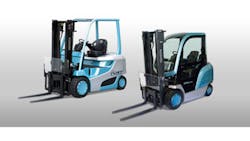Toyota Testing Hydrogen Fuel Cells to Power Forklifts
Toyota will be part of a partnership, consisting of the Kanagawa Prefectural Government, the municipal governments of the cities of Yokohama and Kawasaki, and three private sector companies, to evaluate an end-to-end low-carbon hydrogen supply chain which will use hydrogen produced from renewable energy to power forklifts.
Electricity generated at the Yokohama City Wind Power Plant will be used to electrolyze hydrogen that is compressed, stored, and then transported in a hydrogen fueling truck to four sites: a factory, a vegetable and fruit market, and two warehouses.
At these locations, the hydrogen will be used in fuel cells to power forklifts operating in diverse conditions, Toyota said on March 14.
The company said the low-carbon hydrogen supply chain is expected to “reduce CO2 emissions by at least 80% compared with a supply chain using forklifts powered by gasoline or grid electricity.”
The project's aim is to establish a hydrogen supply chain, investigate costs, and estimate potential CO2 reductions that can be achieved with a full-fledged supply chain in the future.
Toyota provided an overview of the main characteristics of the demonstration project.
1. System to produce hydrogen by electrolyzing water using wind power
Hydrogen Production
· Hydrogen will be produced using renewable energy generated at Hama Wing to operate a water electrolysis system. (Toshiba Corp.)
· The management system will enable flexible, CO2-free, hydrogen production that accounts for temporary discrepancies between power output and hydrogen demand.
2. System to optimize storage and transportation of hydrogen
Hydrogen Storage and Compression
· Sufficient hydrogen to power fuel cells for two days will be stored onsite. (Toyota Turbine and Systems Inc.)
· Electricity will also be stored in an environmentally-friendly storage battery system that re-uses batteries from hybrid vehicle batteries, thus ensuring a stable hydrogen supply even when Hama Wing is not operational.
3. Hydrogen Transportation
· The hydrogen will be compressed for use in forklifts, and delivered in hydrogen fueling trucks (the first of their kind to be used in Japan).
· The consumption of hydrogen by the forklifts will be constantly monitored, so as to ensure optimal transportation and supply to meet user needs.
4. Use of fuel cell forklifts
Hydrogen Utilization
· Twelve forklifts will operate at the four selected locations to demonstrate their viability in a range of operating conditions.(Fuel Cell Forklift
(Toyota Industries Corp.)
· Japan's first fuel cell powered forklifts, which Toyota introduced in February 2016, emit zero CO2 during operation.
